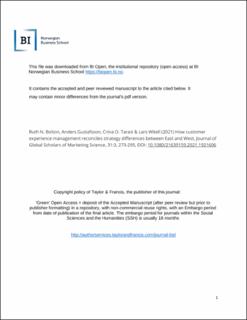How customer experience management reconciles strategy differences between East and West
Journal article, Peer reviewed
Accepted version
Permanent lenke
https://hdl.handle.net/11250/3028211Utgivelsesdato
2021Metadata
Vis full innførselSamlinger
- Scientific articles [2181]
Originalversjon
Journal of Global Scholars of Marketing Science, 2021, 31(3), 273-295, 10.1080/21639159.2021.1921606Sammendrag
This paper studies how customers of a global firm evaluate their experiences within and across 44 countries. It focuses on customers’ emotional, cognitive, sensory and behavioral responses to the catalog experience. It develops a theory-based model of satisfaction with the catalog experience as a function of experiential attributes and control variables. A second model captures how each experiential attribute’s contribution to the customer experience is influenced by market and customer characteristics. The models were operationalized using survey data from 366,185 customers who used the firm’s catalog across different trade areas in 44 countries, yielding 571 equations that describe satisfaction with the customer experience. Consistent with theoretical work on context-dependent judgments, nine contingency factors explain significant and substantial amounts of variation (30% on average) in the elasticities of the 12 experiential attributes. East and West can appear similar when market characteristics are similar – or when they are different. Emotional, cognitive, sensory, and behavioral responses to the customer experience systematically differ due to economic, demographic, technological, cultural and consumer characteristics. East and West especially differ in terms of responses to emotional and sensory experiences. Customer experience management can help to shape a strategy that resolves strategy differences between East and West.
